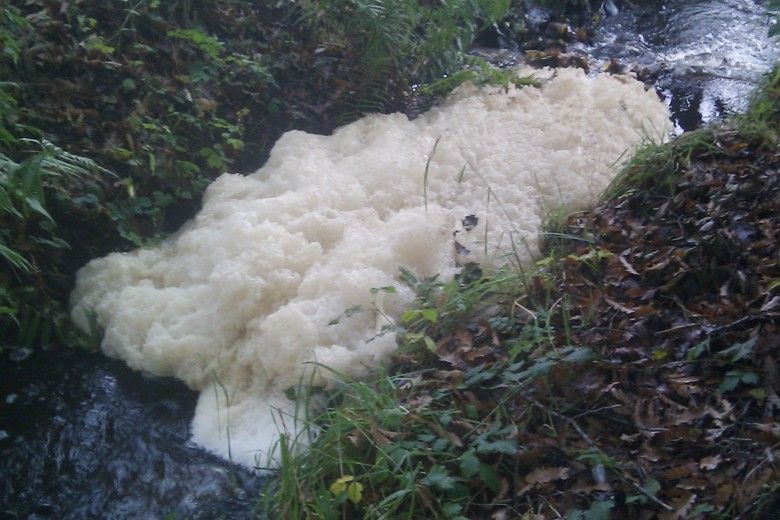Foam in your Stream: Healthy or Harmful?

In these wet summer months, it is not unusual to notice a thick foam accumulating on the surface of your stream. Although it can look unnatural, even alarming, suds on your stream is not all harmful, depending on the type. The tricky part is identifying which foam you have and knowing what to do about it in order to keep your stream healthy!
Natural Suds
Natural suds result from the decomposition of animals and plants, which releases organic surfactants into the water. This is commonly referred to as dissolved organic carbon (DOC), which causes air bubbles, reduces the surface tension of the water, and forms mounds of dense, light-colored bubbles. The DOC in naturally occurring foam provides energy for the stream’s complex aquatic ecosystem, while the foam itself offers shelter and shade for fish and other wildlife.
Human-made Suds
Human-made suds are usually a result of chemical runoff and industrial discharge, such as soap, paint, and pesticides on nearby lawns, fields, and impervious surfaces. The chemicals disrupt the aquatic ecosystem and cause potentially detrimental unbalances.
Which is Which?

Human-made foam, on the other hand, tends to smell fragrant (the product of detergent discharge) or unpleasant (the product of sanitary sewer or septic field failures). Human-made foam is sticky to the touch and usually a pure white color but may turn darker as debris particles filter through. Suds produced by detergents will often dissipate quicker than other types, and rainfall/snowmelt do not contribute to the amount of man-made suds. It will often be found near the point of discharge, so assessing your stream to see if there are pipes or other visible outlets will help you understand if it is human-made or natural foam.
What is the Next Step?
If you suspect your stream is being seriously affected by a contaminant, such as chemical discharge or a sanitary sewer/septic field failure, do not try to remove the foam yourself. For Bucks, Chester, Delaware, Montgomery, and Philadelphia Counties, contact the Pennsylvania Department of Environmental Protection (Southeast Regional Office).
For incidents within the Delaware River watershed (which includes the Brandywine and Christina watersheds) submit a report on the Report a Polluter page on the Delaware Riverkeeper Network website or call the hotline at 1-800-8DELAWARE. In Delaware, contact the Department of Natural Resources and Environmental Control’s Environmental Complaints and Emergency Response line at 800.662.8802.
Images:
Naturally occurring foam on stream (https://creativecommons.org/licenses/by-sa/3.0)
Natural foam gathering against a fallen limb. Photo by Bob Evans, via Loyola Center for Environmental Communication.
Sources:
https://www.fairfaxcounty.gov/publicworks/stormwater/whats-stuff-stream
http://www.arrialaska.org/foam-in-streams.html
http://www.loyno.edu/lucec/natural-history-writings/foam-nature